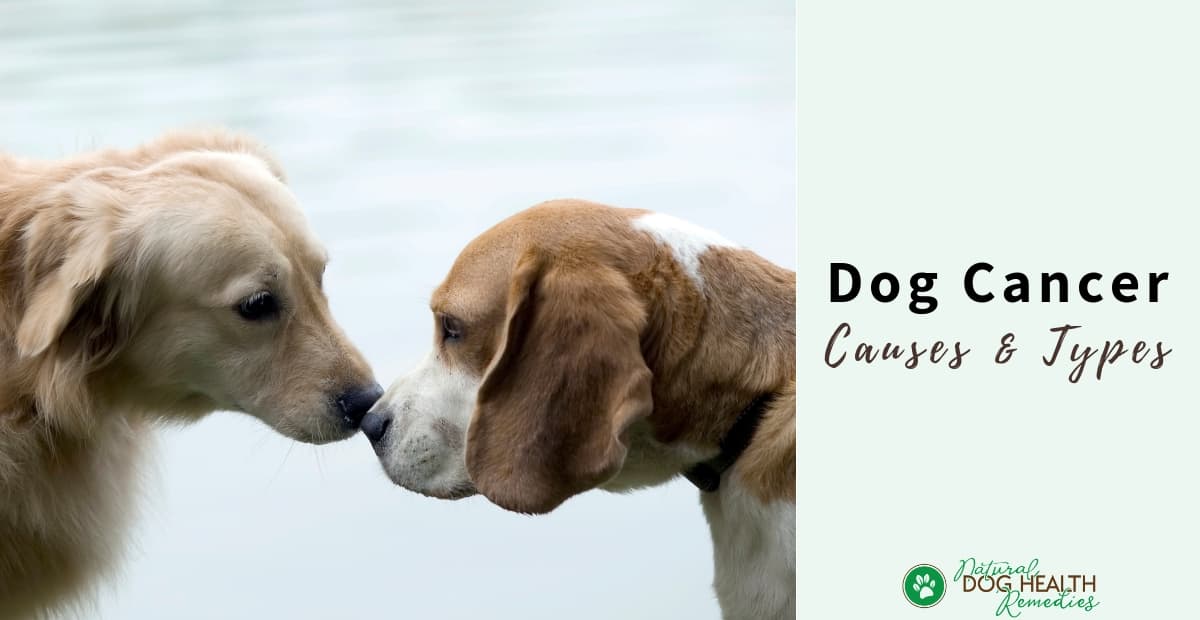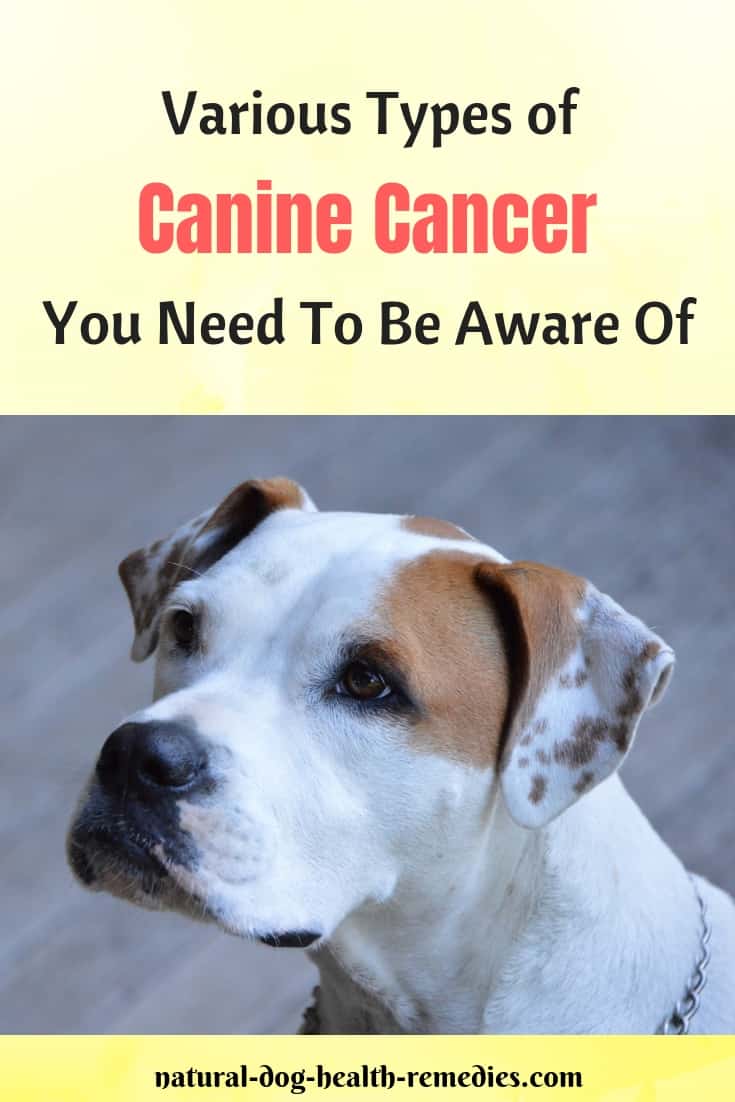Dog Cancer - A Look at the Causes, Types, and Diagnosis

Overview
Cancer can no doubt cause a lot of pain and discomfort to our pets, and can significantly shorten their lives. However, not all cancers carry a poor prognosis.
The key for us dog parents is to educate ourselves more on different types of common dog cancer and their clinical signs, and be more observant for changes in our dogs' behavior and physical conditions.
If we notice some signs that may indicate cancer in our dogs, we should take them for a thorough medical check-up immediately. An early diagnosis can sometimes nip cancer in the bud.
This article looks at the following topics on dog cancer:
- What is Cancer?
- How Does Cancer Kill?
- What Causes Cancer in Dogs?
- What are the Types of Dog Cancer?
- How is Cancer in Dogs Diagnosed?
Looking for Other Information on Dog Cancer?
Here are some more articles (new pages):
What Exactly is Cancer?
All forms of cancer start when there are atypical gene mutations in some susceptible cells. These mutated cells then begin to reproduce and attack other normal, healthy cells. When these atypical cells take over enough normal cells, cancerous tumors form.
As you know, the lifespan of healthy normal cells is limited. They die after a while. This normal cell death is called apoptosis.
However, cancer cells have mutated genes that send abnormal messages to the cells. This causes the cells to prevent apoptosis, allowing them to live indefinitely. When they reproduce by cell division, the mutated genes are passed on to the new cells.
As a result, the cancer cells multiply and spread to wider areas or other parts of the dog's body (metastasis). Once that happens, complications usually occur causing the dog to succumb to cancer.
Many holistic veterinarians suggest that dog cancer is the result of a metabolic imbalance that has gone out of control. The imbalance can be caused not only by numerous outside factors (such as pollutants and poor quality food), but also from within (such as stress).
If a dog is strong and healthy, the immune system can stop the cancer cells from developing and spreading. However, if the immune system is weakened and the body is not in a state of homeostasis, it may be unable to stop cancer cells from growing, resulting in cancerous tumor growth.
How Does Cancer Kill?
Cancer can kill a dog in various ways:
- Locally aggressive cancerous tumors can cause ulcerations and infections resulting in extreme pain. Sometimes due to the location of the tumor, surgical removal is impossible. The only choice may be euthanasia.
- Cancer can cause secondary physical disorders that result in death. For example, acute leukemia in dogs can significantly weaken a dog's immune system, causing the dog to succumb to secondary illnesses.
- A primary cancerous tumor can spread (a process called metastasis) to other parts of the dog's body, causing secondary diseases and death. For example, many cancers metastasize to the lungs, causing difficulty breathing and respiratory arrest and sometimes death.
- Finally, cancer can also kill by consuming a dog's nutrition in the body. The dog, depleted of almost all nutrition, is starved to death.
What Causes Cancer in Dogs?
The exact causes of dog cancer are still unclear, although as mentioned above, all forms of cancer start by genetic mutations that convert normal cells into cancer cells.
It is believed that mutations are usually caused by chronic inflammation or excessive oxidation.
If we look at our living environment, it is not difficult to find a lot of substances that may cause inflammation or excessive oxidation in our dogs' bodies (and ours too). To name just a few:
- Pollution: Polluted air (e.g. cigarette smoke, gas exhaust) and water may contribute to cancer development.
- Toxins: Toxins and harmful chemicals found in some common products (e.g. pesticides, household cleaners, dog flea products, etc.) are also possible culprits. In fact, a study in 1989 showed that dogs receiving just one to two topical pesticide applications had a whopping 60% increase in the risk of developing bladder cancer.
- Low-quality Dog Foods and Treats: Foods and treats that contain artificial colors, flavors, additives, and/or preservatives contain carcinogens that over time can cause a dog to develop cancer. Also, foods with gluten (e.g. wheat) can cause inflammation, and inflammation is associated with a host of chronic diseases, including cancer.
- Radiation: It has been found that dogs, like people, are more susceptible to cancer development if they are frequently exposed to radiation of various forms.
- Over-Vaccination: Many veterinarians now believe that over-vaccination is a possible cause of canine cancer. Instead of giving our dogs booster shots every year, we should consider vaccinating our dogs on an "as-needed" basis.
- Stress: Due to our busy lifestyle, these days we tend to spend less time with our dogs. As a result, more dogs are suffering from depression, anxiety, or boredom.
These kinds of mental stress have an adverse effect on our pets' overall wellbeing as well, weakening their immune system and making them more prone to develop diseases such as cancer.
Types of Dog Cancer
Just like in people, there are quite a few different types of cancer in dogs - some are more common than others, and some are more deadly than others.
Here is an index of different dog cancer types. For detailed information on a specific type of cancer, click on the appropriate link:
How Is Cancer in Dog Diagnosed?
If your dog shows signs of dog cancer, take her to a veterinarian without delay.
The vet will ask for your dog's medical history and general conditions. It is important that you give as much information as possible so that the vet can better assess your dog.
Besides telling your vet the abnormal signs that you are noticing, be prepared to tell the vet the following:
- Your dog's diet.
- Current vaccination status and past vaccination history.
- Past major physical disorders, if any.
- Medications that your dog is taking, conventional and/or alternative.
- Diagnosis and suggested treatment prescribed (If your dog has been to another vet).
After getting your dog's medical history and conducting a thorough physical examination, your dog will be given various laboratory tests, which may include:
Blood tests A complete blood count (CBC) and blood profile are useful for diagnosing diseases, especially when the dog patient shows nonspecific symptoms, such as appetite loss and lethargy.
A complete blood count (CBC) and blood profile are useful for diagnosing diseases, especially when the dog patient shows nonspecific symptoms, such as appetite loss and lethargy.
There is a diagnostic test conducted by Veterinary Diagnostic Institute (VDI) that allows vets to detect cancer before it actually develops in the dog's body. It is based on three values:
- TK (thymidine kinase) Levels
- CRP (C-reactive protein) Levels
- Vitamin D Levels
TK is a measure of dysregulated, abnormal cell growth. An increase in the levels of TK in a dog's blood indicates a high likelihood of tumor development within the next 4-6 months.
CRP levels are elevated in the presence of systemic inflammatory disease.
Studies have shown that cancer and chronic inflammation are closely related. Research shows that very often chronic inflammation may lead to cancer.
CRP levels are good indicators as to whether a dog is suffering from inflammation in the body, and as such whether there is a likelihood of cancer development in the near future.
(Note, however, that elevated CRP levels can also mean the dog is suffering from some diseases other than cancer, such as infections, some autoimmune diseases, and other chronic diseases.)
Vitamin D has been found to have cancer-protective and cancer-killing properties. Low vitamin D levels have been linked to inflammation, cancer, IBD, and other infectious diseases.
By looking at these 3 values, your vet can determine if your dog is healthy, or is a strong candidate for cancer and, if so, preventive measures can be taken at an early stage to prevent or delay the onset of cancer.
Currently, not many vets are using these diagnostic tests to screen dogs for cancer. Talk to your vet about using them to help monitor your dog's health.
UrinalysisA urinalysis is useful to evaluate the dog patient's health; it also provides information that can identify the cause of some of the patient's symptoms.
For example, bladder stones, bladder infections, and bladder cancer share similar symptoms (urinary incontinence, frequent urination, etc.).
A urinalysis may then be done to see if there is blood in the dog's urine. If there is, x-rays can be taken to see if there are stones in the bladder, and if not, an ultrasound can be done to allow early detection of bladder tumors.
X-rays, MRI, CT Scan, and/or UltrasoundX-rays allow the vet to evaluate the dog patient's chest, abdomen and bones. When made correctly, x-rays are the only diagnostic imaging necessary for the vet to properly evaluate them for cancer.
To avoid movement and multiple exposures to x-ray, dog patients have to be sedated while taking x-rays.
When x-rays cannot reveal any abnormalities, sometimes more specialized diagnostic imaging, such as MRI or CT scans, may be required. This is especially true when cancers of the face, sinuses, brain, and spinal cord are suspected.
Dogs are usually put under full anesthesia during these scans.
Fine Needle AspirationFine needle aspiration is a quick and easy way to determine the malignancy of a tumor. The vet inserts a fine needle attached to a syringe into the mass to extract, or aspirate, a tiny amount of fluid or cells by pulling back on the plunger of the syringe.
The material extracted is then examined under the microscope and a proper diagnosis can be made then and there at the veterinary clinic, while the dog parents are waiting.
Sometimes cells cannot be extracted from some tumors, such as soft tissue sarcomas. In these cases, a biopsy is necessary for diagnosis.
BiopsyVery often, tumors are surgically removed (an excisional biopsy) and then a portion of the tissue is sent to a pathologist for examination microscopically.
Occasionally, only a tiny piece of the tumor is removed (an incisional biopsy) for diagnosis.
Since biopsies are surgical procedures, sedation or anesthesia is necessary.
ReferencesEldredge, et al. Dog Owner's Home Veterinary Handbook 4th edition (Wiley Publishing, 2007).
Merck Publishing and Merial. The Merck/Merial Manual for Pet Health (Merck, 2007).
S. Messonnier, The Natural Vet's Guide to Preventing and Treating Cancer in Dogs (New World Library, 2006).





